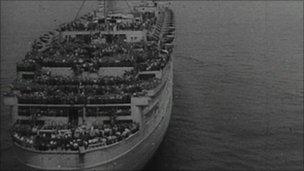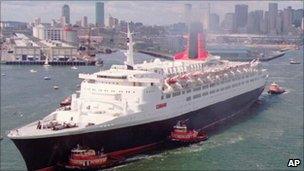New Queen Elizabeth cruise ship faces changing times
- Published

The Queen Elizabeth will set off on her first round-the-world voyage in 2011
As the launch of the cruise ship, the Queen Elizabeth, draws near, there is no doubting that ocean travel has changed from what was once regarded as its golden age.
The third ship in Cunard's fleet, and the third to bear the Elizabeth name, the vessel is the latest chapter in a story spanning 72 years.
The £400m ship is being officially named by the Queen on Monday. In years gone by, such an event would have seen thousands of people straining to view the launch of a new giant on the Solent.
Upon receiving the 92,400-tonne cruise ship from the Italian shipyard where it was built, Cunard president Peter Shanks said he was certain it would be taken into the hearts of the British public, "as they have all the Cunard Queens".
Disaster strikes
The first Queen Elizabeth launched in 1938 as the largest passenger ship ever built, a record held for 56 years.
Tens of thousands of spectators turned out to see the Queen Mother - then Queen Elizabeth, the Queen Consort - and her two daughters at the naming ceremony.
But it wasn't until 1946 that the vessel set sail on its maiden voyage for paying passengers after playing a valiant part in World War II.
Painted grey, the Queen Elizabeth sailed to New York, joining her sister ship the Queen Mary in carrying 15,000 soldiers at a time across the Atlantic.
Winston Churchill claimed the ships' efforts shortened the war by a year.
The QE sailed between Southampton and New York for more than 20 years until its sailing days came to an end in 1968.
Bought by developers, initial plans were drawn up to convert it into a floating university in Hong Kong harbour.
But in 1972 disaster struck when, during refitting, it caught fire and capsized. It was later scrapped.
Floating hotel
The Queen Elizabeth II - or simply the QE2 - was arguably the most famous liner in the world.
Named on the Clyde in 1967 by its namesake, it made its maiden voyage to New York in 1969 and became synonymous with trans-Atlantic luxury and the lifestyles of the rich and famous.
At the time of her retirement in 2008, the QE2 had sailed nearly six million miles, carried 2.5million passengers and echoed its predecessor's wartime efforts, having been requisitioned for the Falklands War in 1982 to transport 3,000 troops.

Wartime prime minister Winston Churchill said the QE helped shorten the war by a year
It served as Cunard's flagship liner until the Queen Mary 2 came into service in 2004.
Thousands turned out to wave goodbye to the 70,327-tonne vessel when it set sail from Southampton in November 2008 for the final time.
It was then sold for £50m to the United Arab Emirates real estate developer Nakheel, which intended to turn her into an exclusive floating hotel off Dubai's manmade Palm Jumeirah resort.
Controversial plans included slicing off the famous giant red funnel and placing it on the waterfront as an entrance.
There was also an idea to relocate the vessel to Cape Town in South Africa, where it would became a hotel for this summer's football World Cup.
With the Southampton name etched off its famous exterior, the ship is currently in dry docks in Port Rashid, Dubai.
A spokeswoman for Dubai World said plans for the vessel's future were still "under review" due to the economic downturn.
'Mass-market'
As it makes its maiden voyage to the Canary Islands on Tuesday, tickets for the new Queen Elizabeth's voyage were snapped up in 29min 14secs when they went on sale in April 2009, becoming the fastest-selling in Cunard's history.
Although the vessel will not be retracing the steps of her predecessors as a trans-Atlantic liner, she will join her sister ship, Queen Victoria, sailing in and out of Southampton.

The QE2 was sold to Dubai property developers for £50m
In 2011, she will embark on her first round-the-world-cruise, a trip which will be repeated the following year.
"We often talk of the 'golden age' of transatlantic travel from Southampton as the 20 years when Queen Elizabeth and Queen Mary sailed to New York," said BBC South Transport Correspondent Paul Clifton.
"But perhaps the real golden age is now. Once the new Queen Elizabeth starts work on Tuesday there will be three Cunard Queens based in the port. All of them bigger than all the ships that went before.
"However, in a way this Queen Elizabeth could be the last of a kind too. Because there are no more new cruise ships on order for the UK market."
- Published1 September 2010